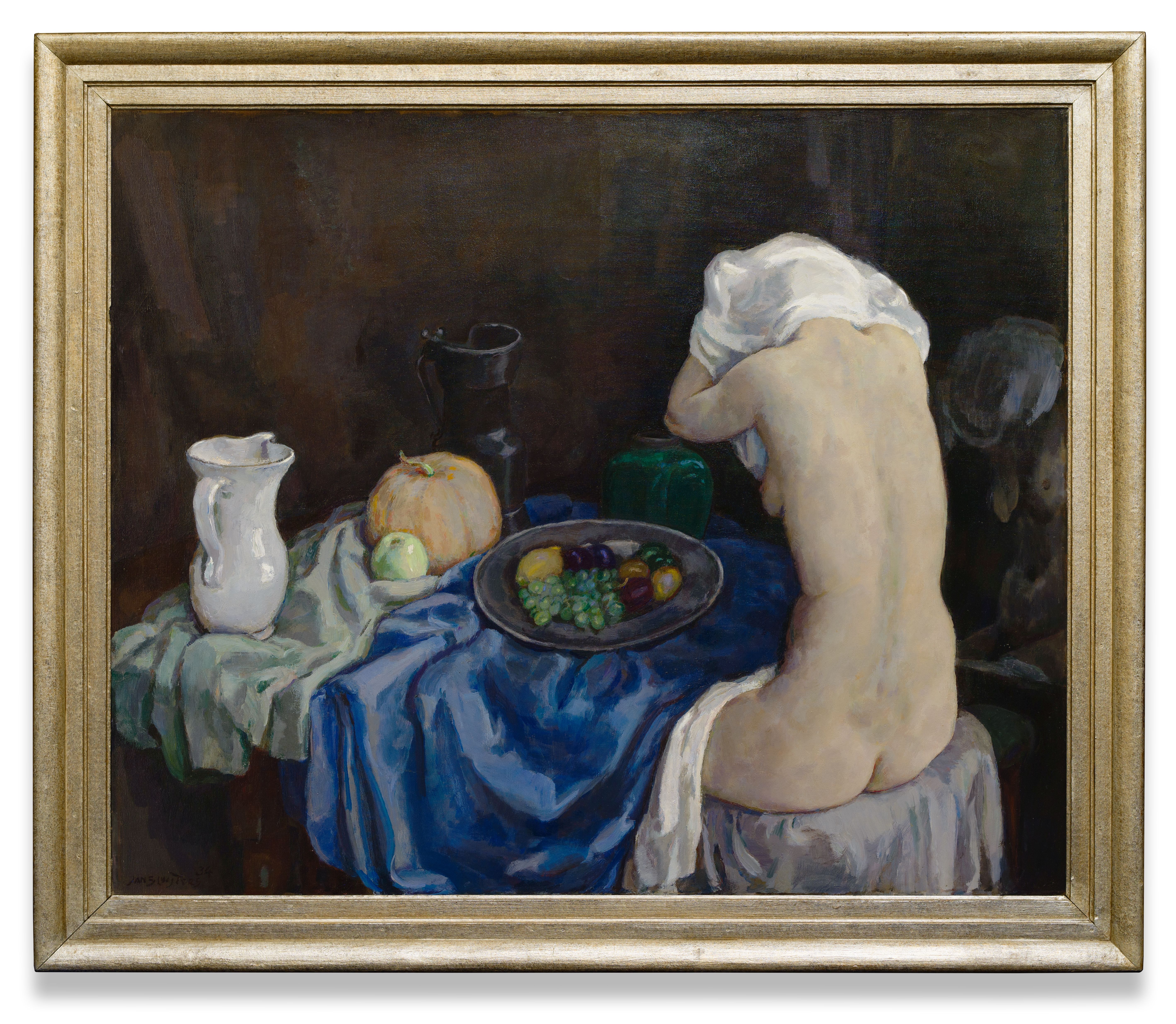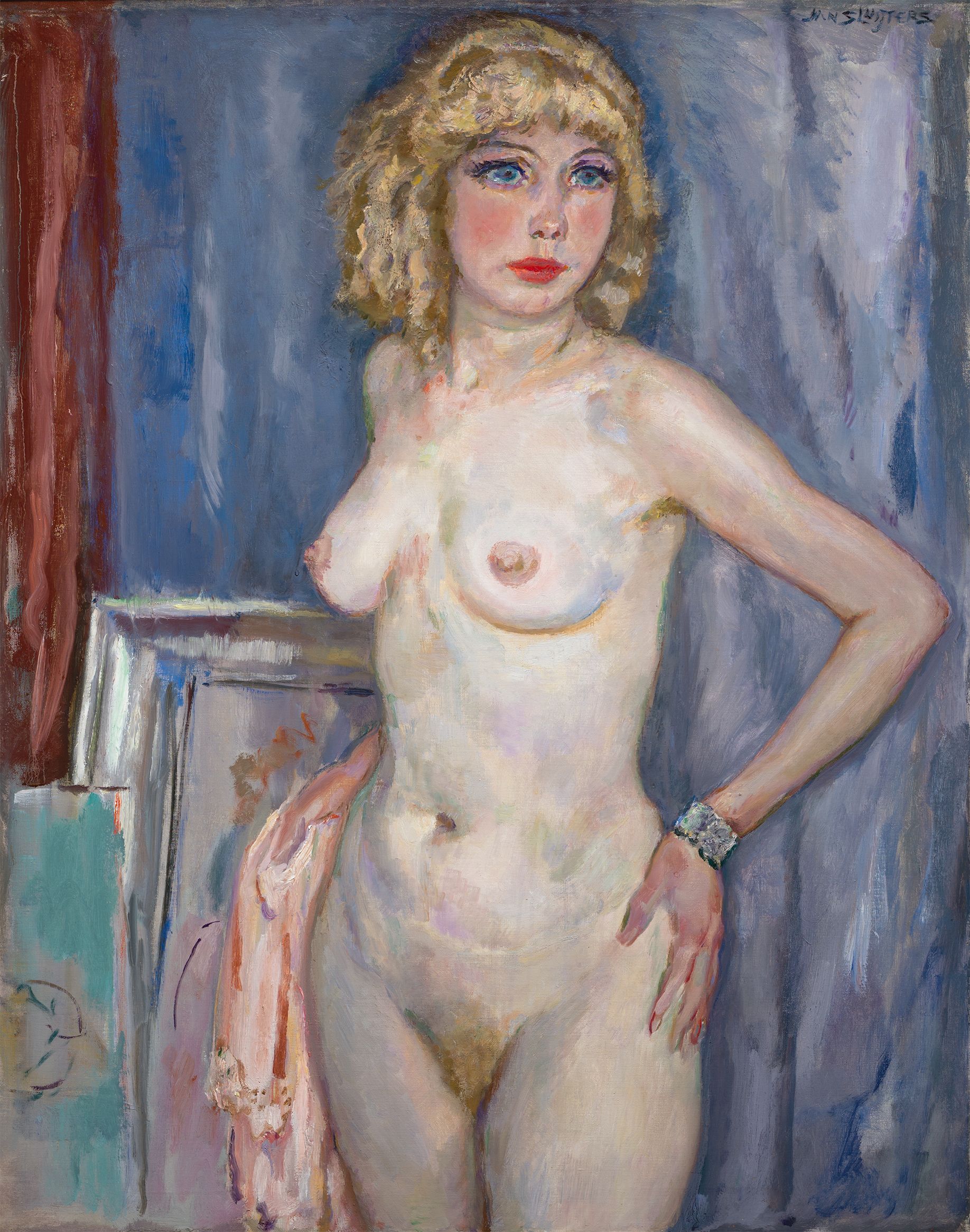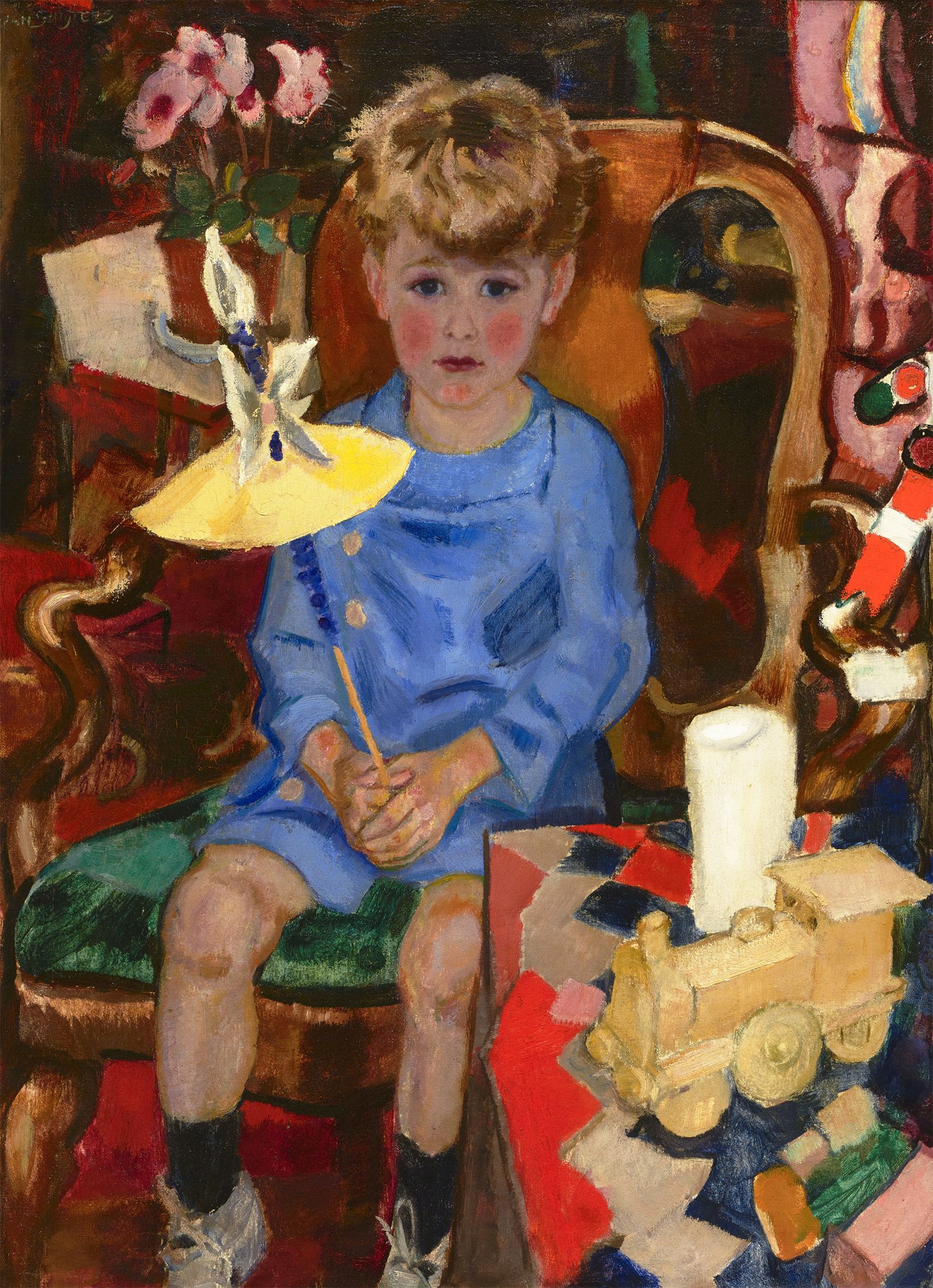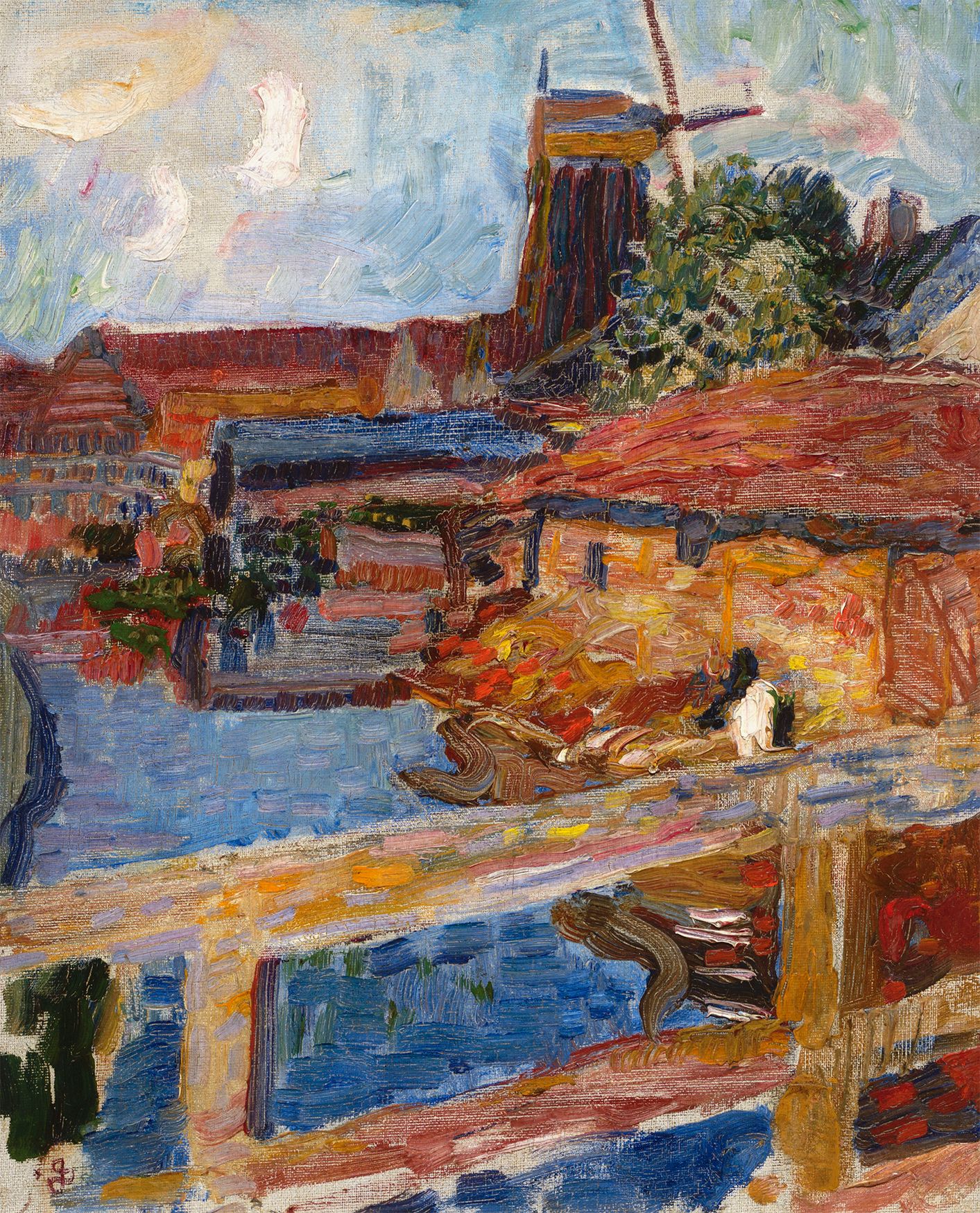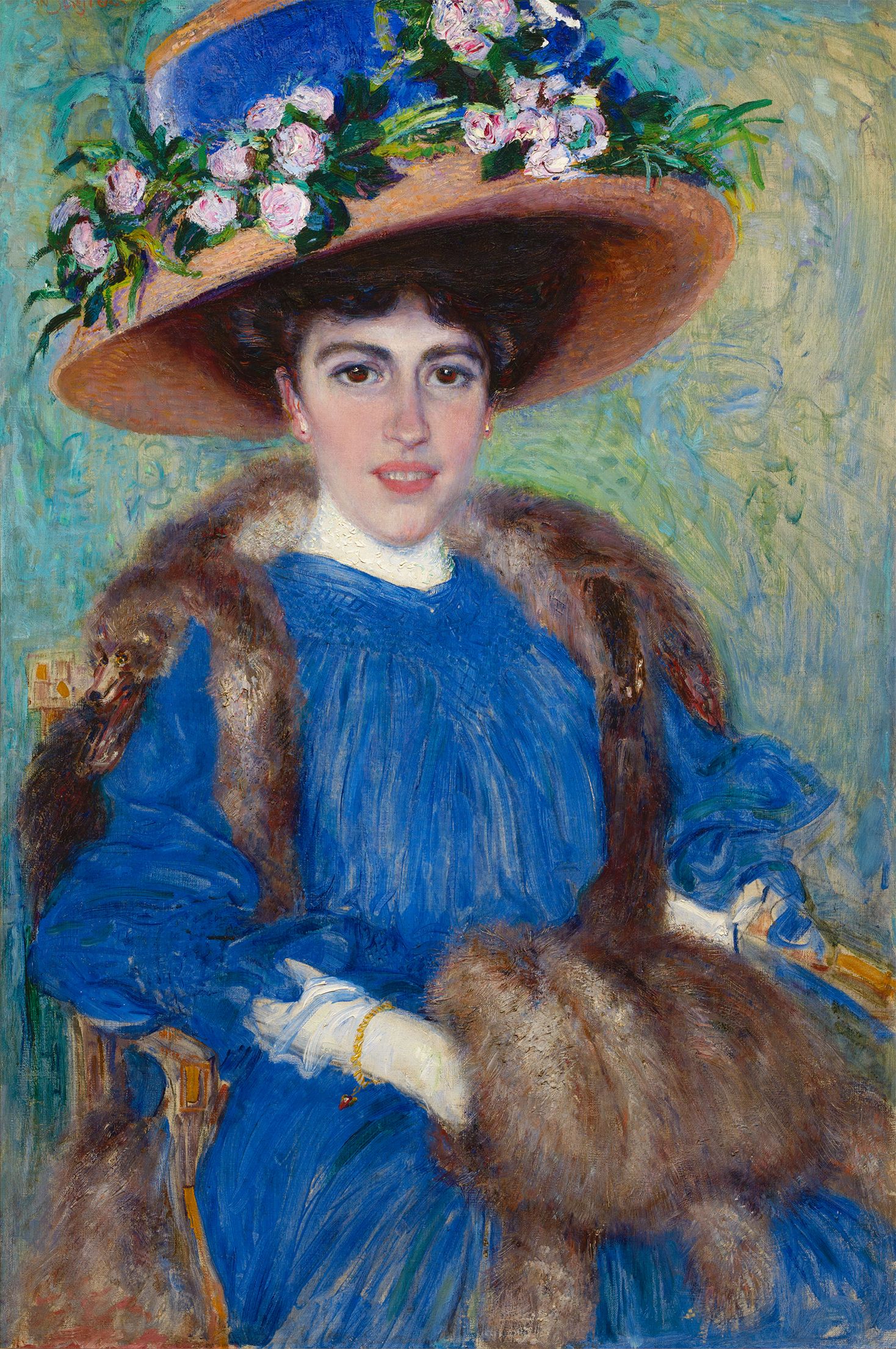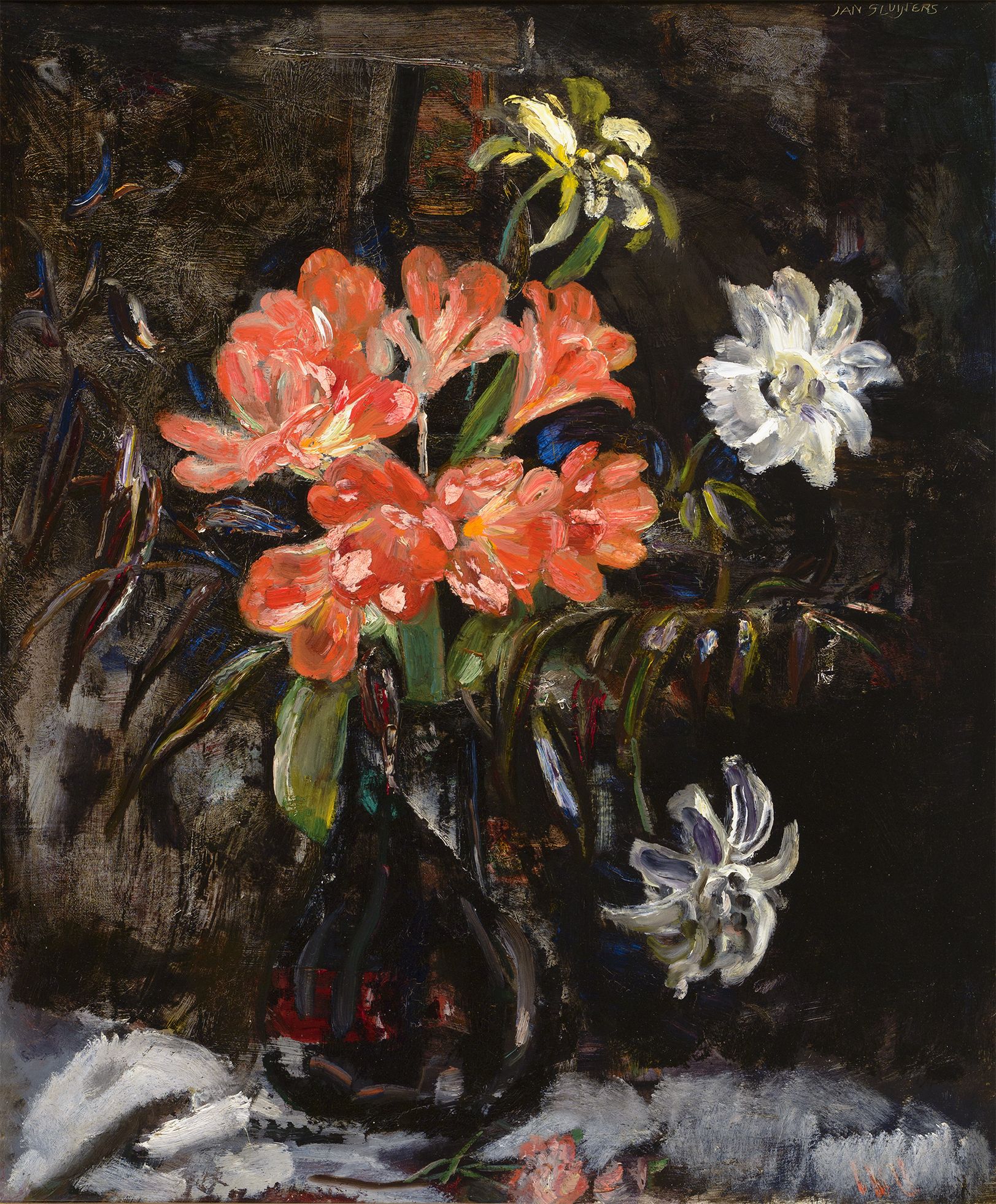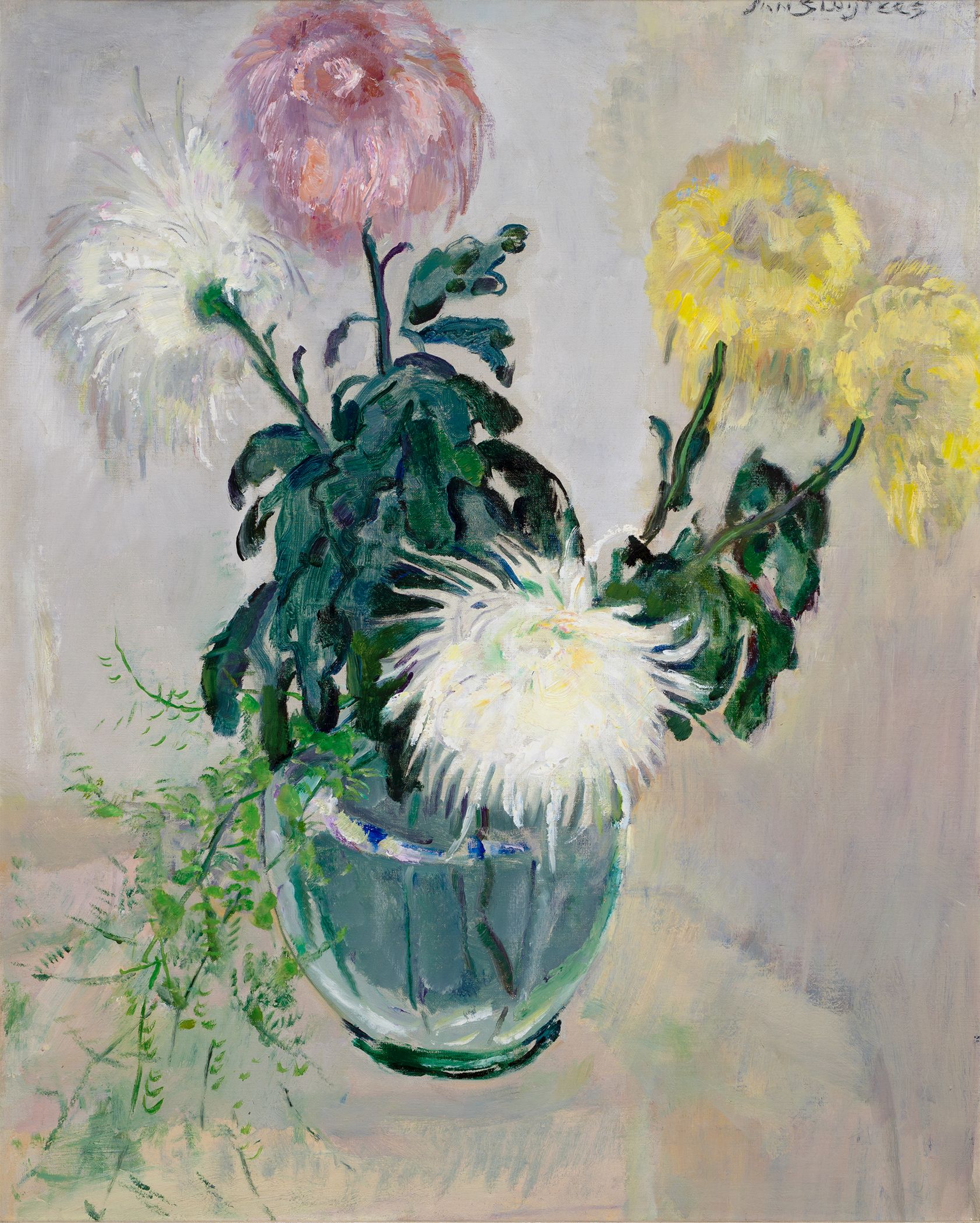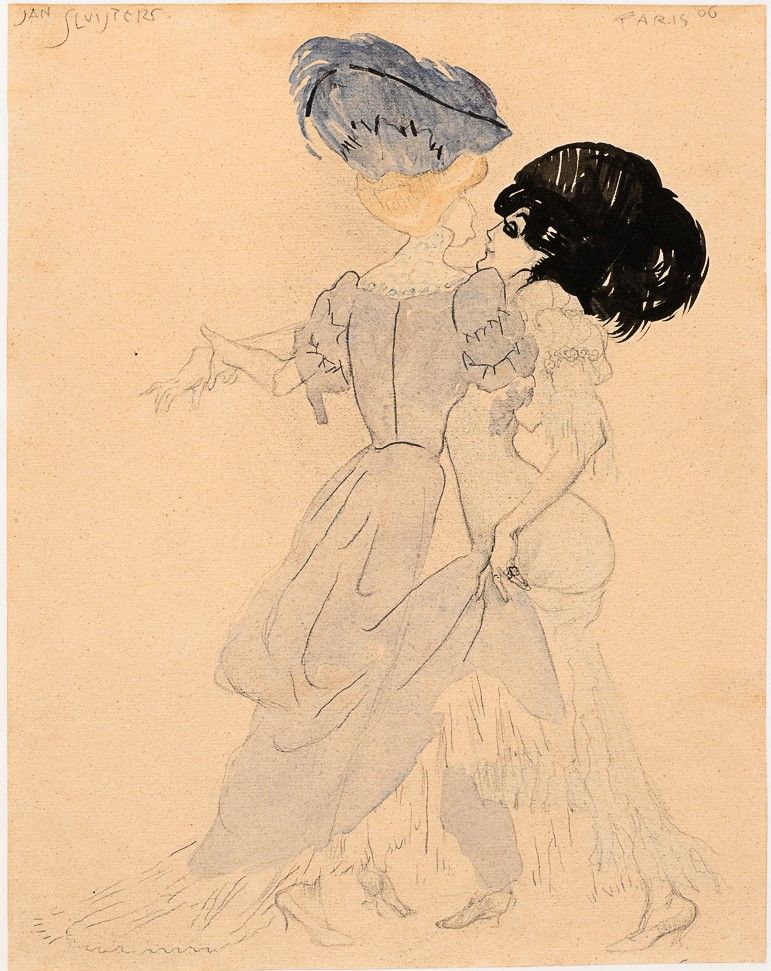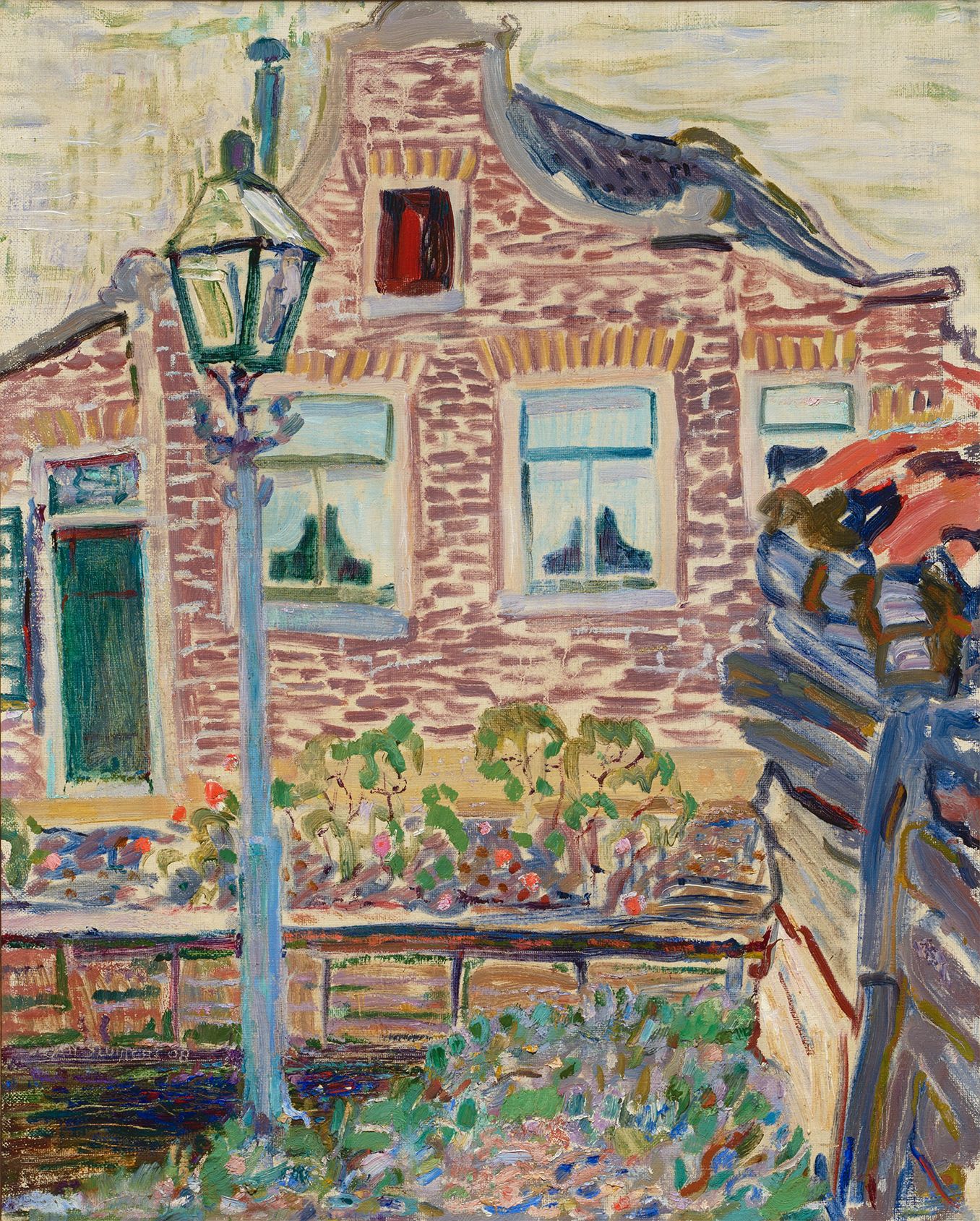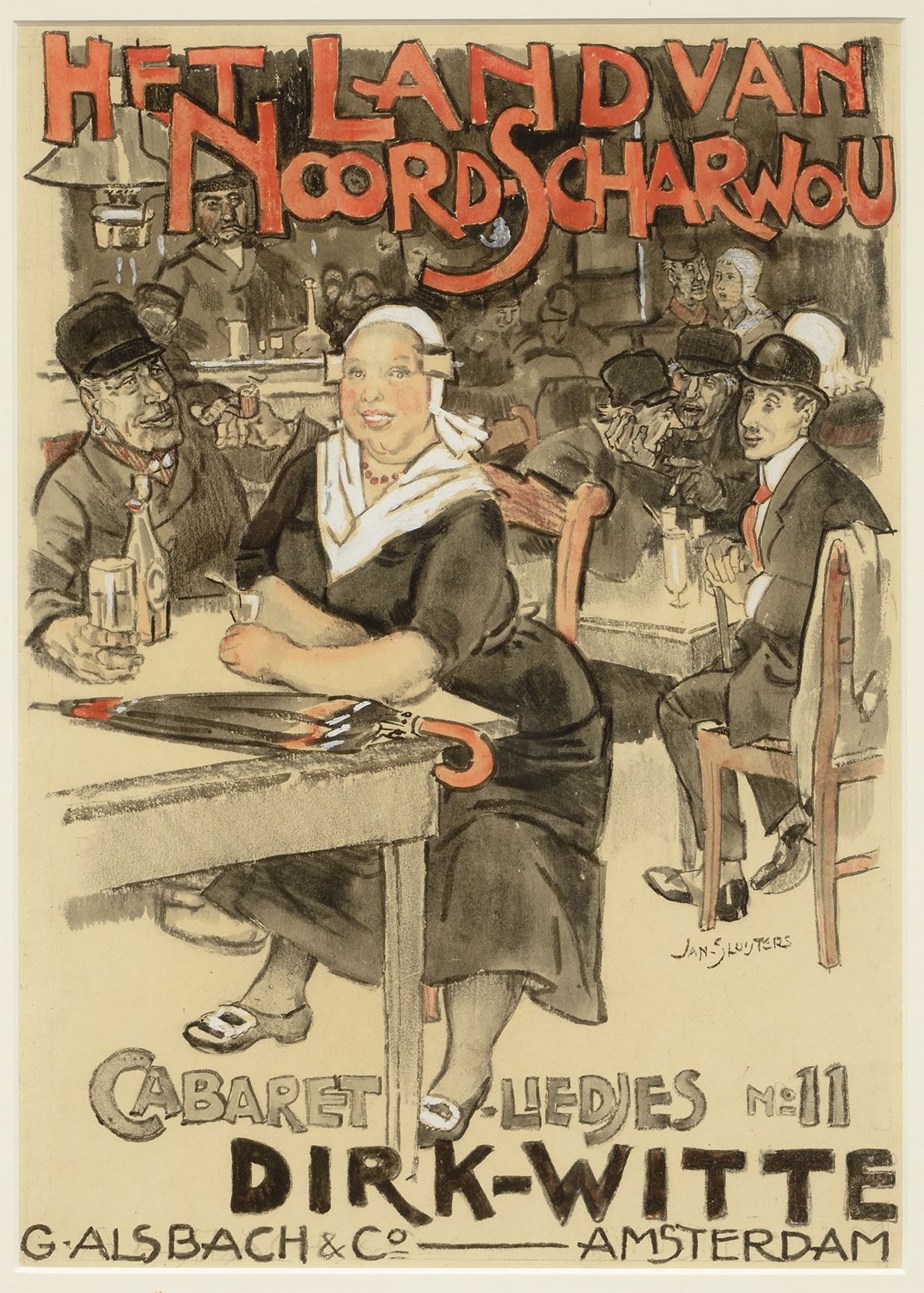J.C.B. (JAN) SLUIJTERS 1881 Bois-le-Duc - 1957 Amsterdam Still Life with Seated Nude
Oil / Canvas: 115 x 140 cm
- This artwork can be viewed in our gallery
- Call us for more information: +31 26 361 1876
- World wide shipping available
Details
Dit stilleven met naakt is een van de bekendste schilderijen uit het rijke en uitgebreide oeuvre van Jan Sluijters. Zelf was hij er erg trots op en hij wilde het nooit verkopen. Hij leende het schilderij wel geregeld uit aan musea in binnen- en buitenland. Na zijn dood in 1957 heeft zijn zoon Jan jr. het nog lange tijd in zijn bezit gehad. Stilleven met zittend naakt is op tientallen tentoonstellingen te zien geweest en staat afgebeeld in vele boeken en catalogi. Het werd direct door de critici bewonderd. In 1936 schreef de krant: 'Het stilleven met zittend naakt (no. 2) treft opnieuw door zijn verfijnde kleur van grijs en blauw met als tegenstelling het groen van een lap en het wit eener kan, terwijl de rug der vrouw als een teedere arabesk van enkel zacht licht is’. NRC schreef in hetzelfde jaar: ‘Het rugnaakt (...) is zoo sterk in het verband met het stilleven gedacht, dat het aan het stilleven deel heeft; het is een stilleven-naakt, dit schilderij, geen interieur met een rug-figuur en een stilleven. Wel is de figuur - waarvan slechts de rug zichtbaar is - een domineerend kleurvlak, waarvan ook de rechtstandigheid heerscht over het stilleven’. Inderdaad is het naakt op dit schilderij onderdeel van het stilleven. Doordat haar hoofd bedekt is heeft het model haar persoonlijkheid verloren en is haar verticale vorm onderdeel van de cirkelvormige compositie die draait om de schaal met vruchten. Door haar grootte is het naakt dominant, maar verder is het model gelijkwaardig aan de andere elementen van het stilleven, en heeft als tegenwicht de witte lampetkan. De kleuren zijn, net als de vormen zorgvuldig op elkaar afgestemd en, typerend voor het werk uit de jaren ‘30, vrij gematigd. Sluijters bleef een colorist: niet met lijnen, maar met kleur, grijzen, groenen en blauw, wist hij de vormen uit de donkere achtergrond naar voren te brengen. De zachte lichtval herinnert aan stillevens uit de Gouden Eeuw. Die combinatie, een naakt en een lampetkan, die de rondingen van het model spiegelt, heeft Sluijters vaak op stillevens uit de jaren '20 en ‘30 toegepast. Sluiters zei er zelf over: ‘Dat schilderij hier: een vrouw en een vaas. Het wit van die lampetkan, de contour daarvan, doen mee aan het sentiment van de vrouw in haar visionaire stemming’.
In de jaren ‘30, de tijd waarin hij dit schilderij maakte, was Jan Sluijters met zijn eigen stijl de beroemdste Nederlandse kunstenaar geworden. Hij stond bekend als schildersbeest, maar was in werkelijkheid een zoekend en hardwerkend schilder met een grote talent en kleurgevoel. In zijn vroege jaren had Sluijters alle nieuwe -ismen in de schilderkunst verwerkt: fauvisme, luminisme en expressionisme, tot hij zijn zijn eigen stijl gevonden had. Evenals vele andere kunstenaars in de jaren twintig maakte Sluijters een ‘retour à l’ordre’: een terugkeer naar een gematigd klassieke, figuratieve stijl. Wat niet veranderde was zijn enorme plezier in het schilderen en zijn uitbundig en geraffineerd gebruik van kleur. Het maakte hem allesbehalve een ouderwetse schilder. Zelfs na de oorlog werd zijn werk een belangrijke inspiratiebron voor de kunstenaars van de CoBrA beweging. De criticus Kasper Niehaus schreef: ‘Hij stak alle stromingen over zonder erin te verdrinken.’ In contrastrijke, felle kleuren, in stoutmoedige verfstreken ontstonden kleurige landschappen en uitbundige bloemstillevens en portretten van prominente Nederlanders. Sluijters maakte veel liefdevolle portretten van zijn gezin, maar vrouwen bleven zijn favoriete onderwerp.
Width: 140 cm
Stedelijk Museum Amsterdam, Amsterdam , inv./cat.nr B1832 - 1953-12-13 on loan from Jan Sluijters, Amsterdam
Private collection Jan Sluijters jr., Hilversum/Loenersloot (Stichtse Vecht)
Stedelijk Museum Amsterdam, inv./cat.nr B2773., Amsterdam
Singer Museum, inv./cat.nr 67-3-1 (on loan from Jan jr. Sluijters, Hilversum), Laren
Art dealer Ivo Bouwman, The Hague
Private collection Amsterdam, 2003
Vrouwen! Muze, model en minnares, Kunsthal Rotterdam, Rotterdam, 2003-09-06 - 2003-30-11, p. 118, nr. 130 (ill.)
Jan Sluijters (Eindhoven 1952), Van Abbemuseum, Eindhoven, 1952-02 - 1952-16-03
Jan Sluijters (Laren 1966-1967), Singer Museum, Laren, 1966-17-12 - 1967-02-12, nr. 40
Jan Sluijters (Den Bosch 1972), Noordbrabants Museum, Bois-le-Duc, 1972-11-11 - 1972-17-12, nr. 51
Jan Sluijters (Den Bosch 1981), Noordbrabants Museum, Bois-le-Duc, 1981-06-06 - 1981-07-26, nr. 61 (ill.)
Ekthesis ollandoon zoographoon 1850-1950 Zappeion , Athens , 1953-11 - 1953-12, cat.no. 63, traveling exhibition also been in Hungary and Israel
Dutch Painting 1850-1950 [Tel Aviv], Tel Aviv Museum of Art, Tel Aviv, 1954-01 - 1954-02, cat. no 72
Tentoonstelling van werken van wijlen Jan Sluijters [Assen], Zaaltje Assen, 1957-20-07 - 1957-10-01, no. 7 (ill.)
Exposition Jan Sluijters (1881-1957), Institut Néerlandais [Parijs], Paris, 1960-04-28 - 1960-05-29, no. 28
Eretentoonstelling van werken van Jan Sluijters, Pictura, Groningen, 1957-06-10 - 1957-10-28, no. 10
Expositie van de te Londen Tentoongestelde nieuwste werken door Jan Sluijters Esher Surrey, The Hague, 1935-01 - 1935-22-11, image on invitation card
Tentoonstelling van schilderijen door Jan Sluijters, Gebouw Leesmuseum, Amsterdam, 1936-29-02 - 1936-22-03, no. 2
Jan Sluijters (Den Haag 1937) G.J. Nieuwenhuizen Segaar, The Hague, 1937
Jan Sluijters (Den Bosch 1941), Openbare Leeszaal, Bois-le-Duc, 1941, no. 11
Jan Sluijters Eeretentoonstelling, Stedelijk Museum Amsterdam, Amsterdam, 1941-04-05 - 1941-05-11, no. 84
Jan Sluyters, Gemeentemuseum 's-Gravenhage, The Hague, 1941-12 - 1942-01, no. 84
Facetten van hedendaagse schilderkunst : België, Luxemburg, Nederland, Gemeentemuseum Den Haag, The Hague, 1949-25-06 - 1949-08-08, nr. 265
Jan Sluijters, Gebouw Kunstoefening, Arnhem, 1950-07-29 - 1950-09-01, no. 26 (ill.)
Jan Sluijters. La Joie de Peindre, Stedelijk Museum Amsterdam, Amsterdam, 1951-12-17 - 1952-01-28, no. 74
Izbor dela : Iz nizozemskog slikarstva od 1850 do 1950 godine [Zagreb] [s.n.] , Zagreb , 1953-05-17 - 1953-06-10, cat.no. 70, traveling exhibition also been in Greece and Israel
Luns 1960, p. 41 (ill.)
Van Calker, 1941, p. 197 (ill.)
H. van Reuth, 'Eeretentoonstelling J. Sluijters', Eindhovense en Meierijsche Courant, 16 Sept. 1941
J.D. Voskuil, 'Hedendaagsche Nederlandsche Kunstenaars. Het werk van Jan Sluyters', Beeldende Kunst, Sept. 1943, p. 1 (ill.)
TABK, 1967, no. 3, p.67 (ill.)
Wessem, 1966, ill. IV, p. 12
J. Juffermans, N. Bakker, "Jan Sluijters. Schilder", 1981, Mijdrecht, p. 121 (ill.)
Artwork is included in the “Catalogue Raisonné” by Jacqueline de Raad of the 'Rijksbureau voor Kunsthistorische Documentatie (RKD)' in The Hague
Permalink https://rkd.nl/explore/images/100713
Over J.C.B. (JAN) SLUIJTERS
Jan Sluijters is among the most important Dutch painters of the first half of the 20th century. In 1904, he won the Prix de Rome. Sluijters became familiar with modern French painting in Paris in 1906/1907 and had a decisive influence on his work. Here he came into contact with new movements in art such as Fauvism (Matisse, De Vlaminck, Roualt, Van Dongen) and Luminism (Seurat, Signac). In the years 1906 - 1916 he earned recognition as one of the great innovators of Dutch painting. In the period when Sluijters was one of the most important representatives of Dutch luminism, especially in the years 1907-1911, the subject of woods, trees, avenues and country roads regularly recurred in his work; more than 15 times - as far as is known - this theme was treated by him either separately or combined. The forest scenes from 1907 and 1908 remind us of the compositions and use of color of Vincent van Gogh (1853-1890). The topography, perspective and accurate rendering of trees and foliage dominate the compositions from these years. Due to private circumstances, Sluijters moved to Heeze in Brabant with his girlfriend Greet van Cooten. There he painted a number of exuberant forest scenes, orchards and farms. Color contrasts, divisionist short paint strokes in horizontal and vertical shapes alongside the longer lines of tree trunks characterize the handwriting. Influence, choice of the same subjects and collaboration between Piet Mondrian (1872-1944), Leo Gestel (1881-1941) and Sluijters has been addressed by many authors. Again, the nature studies of trees in non-realistic colors, which are meant to express an expression of the observation of nature, reveal not only similarities but also differences between the three artists. In 1908 Mondrian painted his famous and monumental "Forest near Oele" (collection Haags Gemeente-museum), which particularly emphasizes horizontal and vertical lines in yellow and blue-violet color contrasts. This painting, first exhibited in January 1909 at a joint exhibition of Kees Spoor (1867-1928), Sluijters and Mondrian at the Stedelijk Museum in Amsterdam, must have made a great impression on Sluijters. The way the trees in the 1910 "Boschlaantje" are given shape and color attests to this influence, but also to Sluijters' greater emphasis on the more colorful range of colors: blue, violet, yellow, red, black and many varieties of green. Perspective played less and less of a part in forest scenes of 1910 and 1911; in the "Boschlaantje" indicated only by the location of the trees and the short brushstrokes of the road. As in the "Forest near Oele," the trees and crests reach into the sky and conclude the painting at the top. Horizon and foliage flow smoothly into each other. The paintings Sluijters made in 1910 are some of the finest works of his luminist period. Such is the case with "Boschlaantje," in which the interplay of short and long lines, broad and narrow areas of color plays out in an almost abstract manner. Yet Sluijters continues to see the forest through the trees; the composition remains recognizable. Sluijters was not concerned with "the search for effect, to show off colors," as he confided to his painter friend Kees Spoor in 1910, but with expressing in paint "a fiercer sense of superiority of spirit, which is moved by the things that stand above the mere optical perceptible." During 1911, coinciding with his departure from Laren, Sluijters broke with luminism and took a different artistic path.

